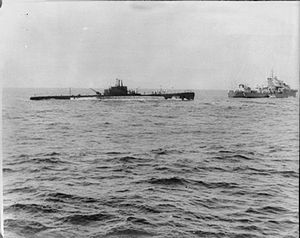
HMS Kelvin was a K-class destroyer of the Royal Navy laid down by the Fairfield Shipbuilding and Engineering Company, Limited, at Govan in Scotland on 5 October 1937, launched on 19 January 1939 and commissioned on 27 November 1939 with the pennant number F37.

HMS Kingston was a K-class destroyer built for the Royal Navy during the 1930s.
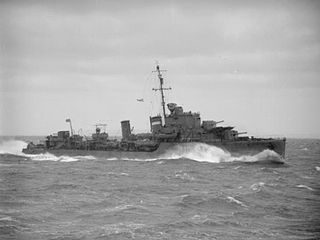
HMS Intrepid was one of nine I-class destroyers built for the Royal Navy during the 1930s.

HMS Imogen was a I-class destroyer built for the Royal Navy in the mid-1930s. During the Spanish Civil War of 1936–1939, the ship enforced the arms blockade imposed by Britain and France on both sides as part of the Mediterranean Fleet. After the start of the Second World War the ship was transferred to Home Fleet and participated in the Norwegian Campaign in April 1940. Imogen sank two German submarines before her own sinking following an accidental collision in July 1940.
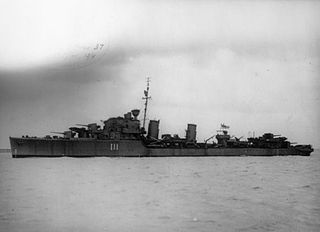
HMS Impulsive was an I-class destroyer built for the Royal Navy during the 1930s. She saw service in World War II before being scrapped in 1946. She has been the only ship of the Navy to bear this name.
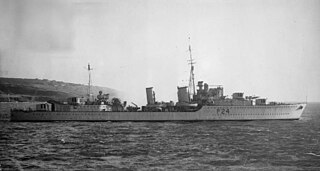
HMS Maori was a Tribal-class destroyer named after the indigenous Māori people of New Zealand. She served with the United Kingdom Mediterranean Fleet during World War II until she was bombed and sunk by German aircraft while at Malta in 1942. Her wreck was later raised and scuttled outside the Grand Harbour. The wreck is now a dive site.

HMS Icarus was one of nine I-class destroyers built for the Royal Navy during the 1930s.

HMS Eskimo was a Tribal-class destroyer, Eskimo served throughout the Second World War, seeing action in Norway, the Mediterranean, the English Channel and in Burma. After the war Eskimo was used as an accommodation and headquarters ship, finally being used as a practice target before being scrapped in 1949.

HMS Sikh was a Tribal-class destroyer of the British Royal Navy. The ship entered service in 1938 and served during the Second World War, participating in the sinking of Bismarck and the Battle of Cape Bon. In 1942, while participating in a commando raid, Sikh was sunk by a combination of shore artillery, anti-aircraft guns and aerial bombs.

HMS Amazon was a prototype design of destroyer ordered for the Royal Navy in 1924. She was designed and built by Thornycroft in response to an Admiralty request for a new design of destroyer incorporating the lessons and technological advances of the First World War. Their great rivals Yarrow produced a similar, competitive design — that of Ambuscade.

The J, K and N class consisted of 24 destroyers built for the Royal Navy beginning in 1938. They were a return to a smaller vessel, with a heavier torpedo armament, after the Tribal class that emphasised guns over torpedoes. The ships were built in three flotillas or groups, each consisting of eight ships with names beginning with "J", "K" and "N". The flag superior of the pennant numbers changed from "F" to "G" in 1940.

HMS Nubian was a Tribal-class destroyer of the Royal Navy that saw much distinguished service in World War II. She won 13 battle honours, a record only exceeded by one other ship, and matched by two others.

HMS Somali was a Tribal-class destroyer of the British Royal Navy that saw service in World War II. She was launched in 1937, captured the first prize of World War II and served in Home and Mediterranean waters. She was torpedoed on 20 September 1942 in the Arctic and foundered five days later while under tow.

HMS Bedouin was a Tribal-class destroyer of the British Royal Navy that saw service in World War II.

HMS Brazen was a B-class destroyer built for the Royal Navy around 1930. Initially assigned to the Mediterranean Fleet, she was transferred to Home Fleet in 1936. The ship escorted convoys and conducted anti-submarine patrols early in World War II before participating in the Norwegian Campaign in April–May 1940. Brazen later began escorting coastal convoys in the English Channel and was sunk in late July 1940 by German aircraft whilst doing so.
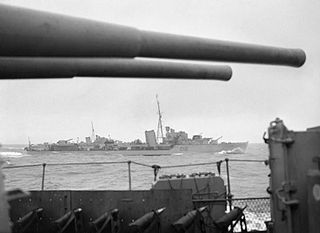
HMS Kashmir (F12) was a K-class destroyer built for the Royal Navy during the 1930s, named after the princely state of Kashmir in British India.

HMS Active, the tenth Active, launched in 1929, was an A-class destroyer. She served in the Second World War, taking part in the sinking of four submarines. She was broken up in 1947.

HMS Escapade was an E-class destroyer built for the Royal Navy in the early 1930s. Although assigned to the Home Fleet upon completion in 1934, the ship was attached to the Mediterranean Fleet in 1935–1936 during the Abyssinia Crisis. During the Spanish Civil War of 1936–1939 she spent considerable time in Spanish waters, enforcing the arms blockade imposed by Britain and France on both sides of the conflict. Escapade was assigned to convoy escort and anti-submarine patrol duties in the Western Approaches when World War II began in September 1939, but transferred back to the Home Fleet at the end of the year.

HMS Havelock was an H-class destroyer that had originally been ordered by the Brazilian Navy with the name Jutahy in the late 1930s, but was bought by the Royal Navy after the beginning of the Second World War in September 1939 and later renamed. She participated in the Norwegian Campaign in May 1940 and was assigned to convoy escort and anti-submarine patrols with the Western Approaches Command afterwards. The ship was briefly assigned to Force H in 1941, but her anti-aircraft armament was deemed too weak and she rejoined Western Approaches Command. Havelock became flotilla leader of Escort Group B-5 of the Mid-Ocean Escort Force in early 1942 and continued to escort convoys in the North Atlantic for the next two years. The ship was converted to an escort destroyer and sank one submarine during the war. After the end of the war, she escorted the ships carrying the Norwegian government in exile back to Norway and served as a target ship through mid-1946. Havelock was scrapped beginning in late 1946.

HMS Kipling (F91) was a K-class destroyer built for the Royal Navy during the 1930s.
